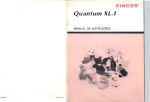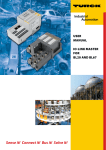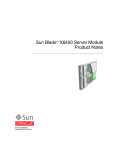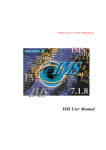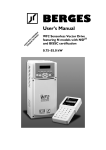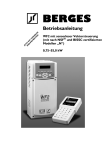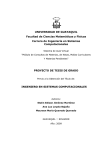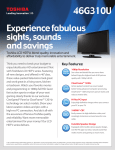Download Qume DataTrak 8 Hardware manual
Transcript
JADE COMPUTER PRODUCTS PRESENTS Double D THE DOUBLE DENSITY DISK CONTROLLER HARDWARE MANUAL IOD-1200M REVISION C Copyright (C) 1980 Jade Computer Products 4901 Rosecrans Ave Hawthorne, California 90250 All Rights Reserved 1 JADE COMPUTER PRODUCTS 4901 W. ROSECRANS BLVD HAWTHORNE. CALIF 90250 SUBJECT: PRODUCT: REVISION: DATE: ENGINEERING CHANGE NOTICE # 1. DOUBLE D DISK CONTROLLER. BAND C REVISION BOARDS. AUGUST 4. 1980. IT HAS BEEN REPORTED THAT INSERTION OF THE DOUBLE D DISK CONTROLLER INTO OF SOME S100 SYSTEMS PREVENTS NORMAL OPERATION. USUALLY ON THESE SYSTEMS THE COMMON CHARACTERISTIC IS THAT THEY JUST WILL NOT OPERATE. PLEASE NOTE S100 BUS PINS #20, #53, AND #70 ARE CONNECTED TO GROUND, AS PER S100 STANDARDS, IEEE TASK 696.1/D2. THESE PIN CONNECTIONS DO CAUSE INTERFERANCE WITH IMSAI FRONT PANEL SYSTEMS OR CPU BOARDS DESIGNED TO OPERATE WITH FRONT PANELS. IT IS PERMISSABLE TO CUT THE FOIL LINKS CONNECTING PINS #20, 53, AND 70 TO THEIR RESPECTIVE PLATE-THRU-HOLES. PLEASE VERIFY IN YOUR SYSTEM DOCUMENTATION THAT THESE PINS ARE CAUSING INTERFERENCE BEFORE CUTTING. ---------------------------------------------------------------SUBJECT: PRODUCT: REVISION: DATE: ENGINEERING CHANGE NOTICE # 2. DOUBLE D DISK CONTROLLER. BAND C REVISION BOARDS. AUGUST 4, 1980. A REVIEW OF THE DOUBLE D 8" PHASE LOCKED LOOP HAS BEEN COMPLETED. THIS HAS RESULTED IN A RESELECTION OF SOME COMPONENT VALUES. ENHANCED OPERATION, PARTICULARLY IN DOUBLE DENSITY, WILL BE REALIZED WITH THE FOLLOWING MODIFICATION. THIS MODIFICATION WILL DOUBLE THE LOOP CAPTURE RANGE AND ALSO ELIMINATE A CAUSE OF LOOP INSTABILITY. WITH THE EXCEPTION OF Rl, JUST CHANGE THOSE RESISTORS LISTED FOR THE NEW VALUES AS SHOWN IN THE LIST. Rl DOES HAVE A CHANGED VALUE BUT ALSO MUST BE INSTALLED SO THAT IT WILL CONNECT TO +5 VOLTS REGULATED INSTEAD OF THE PREVIOUS CONNECTION TO VX. WITH CAREFUL LEAD BENDING AND RESISTOR PLACEMENT, ONE LEAD CAN SOLDER TO THE +5V FOIL RUNNING FROM PIN #16 OF IC lA TO PIN #16 OF IC lB. IT WOULD HELP TO SCRAPE SOME OF THE SOLDER MASK AWAY BEFORE SOLDERING Rl TO THIS FOIL. VX WILL NOW MEASURE ABOUT +5.0 VOLTS. INSTALLATION OF THE MODIFICATION WILL REQUIRE RETUNING THE PLL. Rl 6.8K 1/4W (TO +5V) R42 470K 1/4W R3 12K 1/4W R43 2.7K 1/4W R4 10K 1/4W R49 JUMPER R38 20K 1/4W ---------------------------------------------------------------2 ---------------------------------------------------------------SUBJECT: PRODUCT: REVISION: DATE: ENGINEERING CHANGE NOTICE # 3. DOUBLE D DISK CONTROLLER. BAND C REVISION BOARDS. AUGUST 4, 1980. THE DOUBLE D DISK CONTROLLER USES S-100 SIGNAL SWO*. CPUS SUCH AS SBC-I00 AND SBC-200 DO NOT GENERATE THESE SIGNALS AND THEREFORE PRESENT AN INTERFACE PROBLEM. THE FOLLOWING MODIFICATION HAS SOLVED THE PROBLEM WITH THE ABOVE MENTIONED BOARDS. 1. ON THE SOLDER SIDE OF THE BOARD: CUT THE FOIL LINK FROM S-100 PIN # 97 TO THE PLATE-THRU-HOLE. 2. ON THE SOLDER SIDE OF THE BOARD: USING A SMALL GAUGE WIRE JUMPER IC 1H PIN #2 TO IC 3J PIN #1. ---------------------------------------------------------------SUBJECT: PRODUCT: REVISION: DATE: ENGINEERING CHANGE NOTICE # 4. DOUBLE D DISK CONTROLLER. BAND C REVISION BOARDS. AUGUST 4, 1980. THE DOUBLE D DISK CONTROLLER EXHIBITS ERRATIC OPERATION WHEN RUN WITH. THE BIG-Z Z80 CPU BOARD. THE PROBLEM EXISTS ON THE BIG-Z BOARD. THE FOLLOWING MODIFICATION FIXES THIS PROBLEM. NOTE: THE BIG-Z DOES NOT SEND OUT WRITE DATA TO THE S-100 BUS UNTIL IT ACTUALLY SENDS THE WRITE STROBE. THIS MODIFICATION ALLOWS THE WRITE DATA TO SETTLE ON THE S-100 BUS BEFORE THE WRITE STROBE IS ISSUED. 1. 2. ON THE SOLDER SIDE BIG-Z: CUT THE FOIL FROM IC 22 PIN # 13. ON THE SOLDER SIDE BIG-Z: JUMP IC22 PIN # 13 TO PIN # 3. ---------------------------------------------------------------- 3 ---------------------------------------------------------------SUBJECT: ENGINEERING CHANGE NOTICE # 5B. PRODUCT: DOUBLE.D DISK CONTROLLER. REVISION: BAND C REVISION BOARDS. DATE: AUGUST 5. 1980. IMPORTANT NOTICE! BOARD MODIFICATION NEEDED ON REVISION C. THIS ECN PERTAINS TO THE USE OF THE DOUBLE D DISK CONTROLLER WITH JADE RELEASE # 2 OF CP/M 2.2. CONNECTOR J3 PIN #48 WAS DESIGNATED ILLEGAL PACK*. IT HAS BEEN REDEFINED AND IT IS NOW DESIGNATED TWO SIDED*. MANY SHUGART SA800/801. SIEMENS FD100-8. AND OTHER MODELS OF DISK DRIVES HAVE OPTIONAL DATA SEPERATORS INSTALLED. DISK DRIVES USING THESE OPTIONS USE PIN #48 OF THE 50 LINE RIBBON FOR THE SEPERATED DATA* SIGNAL. AS RELEASE #2 (SPECIFICALLY DCM2) MONITORS THIS SIGNAL LINE FOR TWO SIDED* ERRATIC DISK OPERATION WOULD BE EXPECTED. PLEASE CUT THE FOIL LINK BETWEEN THE TWO PLATE-THRU-HOLES AT J3 PIN #48 (REVISION C). FOR USE WITH THE SA850/851 DISK DRIVE A JUMPER SHOULD BE INSTALLED .ON THE J3 PATCHING AREA FROM THE LOWER PIN # 48 PLATE-THRU-HOLE TO THE UPPER PIN #10 PLATE-THRU-HOLE. THIS COMPLETES THE PATH FOR THE TWO SIDED* SIGNAL FROM THE SA850/851. . ---------------------------------------------------------------SUBJECT: PRODUCT: REVISION: DATE: ENGINEERING CHANGE NOTICE # 6. DOUBLE D DISK CONTROLLER. BAND C REVISION BOARDS. AUGUST 5, 1980. NOTE: CONCERNING THE DOUBLE D DISK CONTROLLER WHEN USED WITH 64K OF SYSTEM MEMORY OR ANY OTHER MEMORY ARRANGEMENT WHERE THE DOUBLE .D MEMORY WINDOW OVERLAPS ASSIGNED MEMORY SPACE. WHEN USED IN THIS CONFIGURATION THE PHANTOM BLOCK MUST BE JUMPERED TO COMPLETE THE PHAN* SIGNAL PATH TO THE S100 BUS. THE PHANTOM BLOCK IS LOCATED BELOW IC 4D. IT APPEARS AS TWO PLATETHRU-HOLES ENCLOSED BY A SILKSCREEN BORDER LABELED PHAN*. ADD A JUMPER CONNECTING THESE TWO HOLES TOGETHER. ANY MEMORY BOARD THAT THE DOUBLE D IS TO OVERLAP MUST BE CONFIGURED SO AS TO BE DISABLED WHEN RESPONDING TO THE PHANTOM SIGNAL (PHAN*). ---------------------------------------------------------------- 4 ---------------------------------------------------------------SUBJECT: PRODUCT: REVISION: DATE: ENGINEERING CHANGE NOTICE # 7. DOUBLE D DISK CONTROLLER. BAND C REVISION BOARDS. OCTOBER 6, 1980. NOTE: USE NATIONAL SEMICONDUCTOR 74LS123 ONE-SHOTS ON THE DOUBLE-D CONTROLLER BOARD. THE RESISTOR / CAPACITOR COMBINATIONS HAVE BEEN SELECTED TO PROVIDE PROPER PULSE PERIODS WHEN USED WITH THIS ONE-SHOT. DOUBLE D DISK CONTROLLER BOARDS (A&T AND KIT) ARE NOW SUPPLIED WITH NATIONAL SEMICONDUCTOR 74LS123S. CUSTOMERS WHO BUILD DOUBLE D BARE BOARDS TAKE NOTE. ---------------------------------------------------------------SUBJECT: PRODUCT: REVISION: DATE: ENGINEERING CHANGE NOTICE # 8. DOUBLE D DISK CONTROLLER. C REVISION BOARDS. OCTOBER 6, 1980. THE FOLLOWING LIST CONTAINS CORRECTIONS TO THE DOUBLE D REVISION C SCHEMATIC OF 3/7/80. PLEASE MAKE THESE CORRECTIONS TO YOUR DIAGRAMS. 1. THE OUTPUT OF IC 1M (7406) PIN 6 TO THE PLATETHRU HOLE IN THE INTERRUPT BLOCK SHOULE BE LABELED DINT*. (PAGE 1) 2. A SECTION OF IC 3L (PINS 5 AND 15) HAS BEEN DRAWN AND LABELED AS A 74LS244. THIS IS SHOWN ON PAGE 1 CONNECTED TO THE 1791. THIS PART IS A 74LS240. 3. AN INVERTING BUFFER, PART OF IC 3L (74LS240) PINS AND 9, IS NOT SHOWN IN THE DIAGRAM. PIN 11 IS THE INPUT AND I CONNECTED TO DDEN. PIN 9 IS THE OUTPUT AND IS THE SOURCE FOR DDEN*. 4. FOUR PIN ASSIGNMENTS OF IC 3H (8131) ARE IN ERROR. CHANGE PIN 13 TO PIN 11, PIN 12 TO PIN 10, PIN 11 TO PIN 13, AND PIN 10 TO PIN 12. (PAGE 1) 5. THE INPUT TO IC 4A ON PIN 13 IS LABELED AS BPWR*. THIS LABEL SHOULD READ AS BPWR. (PAGE 2) ---------------------------------------------------------------- 5 ---------------------------------------------------------------SUBJECT: PRODUCT: REVISION: DATE: ENGINEERING CHANGE NOTICE # 9. DOUBLE D DISK CONTROLLER. BAND C REVISION BOARDS. OCTOBER 6. 1980. THE FOLLOWING JUMPER CONFIGURATION CAN BE USED WITH THE SHUGART SA800/801 MODEL DISK DRIVE. EACH DRIVE: A, DRIVE DRIVE DRIVE DRIVE DSI DS2 DS3 DS4 A: B: C: D: LAST DRIVE: Tl, B, C, Y, T2, T3, T4, T5, T6 HL, 800 THE L JUMPER IS SET DEPENDING ON THE -5V SUPPLY. CONSULT YOU SA800 MANUAL. USE NO OTHER JUMP PLUGS IN THIS CONFIGURATION. SIEMENS DISK DRIVE MODELS FD120-8B AND THE NEWER FD100-8D CAN BE USED THE JADE DOUBLE D. EACH DRIVE MUST HAVE THE RADIAL SELECT OPTION PLUG SET TO THE PROPER DRIVE NUMBER" 0 SELECTS DRIVE A, 1 SELECTS DRIVE B, 2 SELECTS DRIVE C, AND 3 SELECTS DRIVE D. ONLY THE LAST DRIVE ON THE RIBBON SHOULD CONTAIN THE RESISTOR PACK. BE SURE TO REVIEW ECN #5. NO OTHER CHANGES ARE NEEDED. THE FOLLOWING PAGE DESCRIBES A TESTED JUMPER CONFIGURATION FOR THE SHUGART SA850/851 WHEN USED WITH JADE RELEASE # 2 OF CP/M 2.2. 6 SHUGART SAS50/S51 ------- --------START WITH THE DISK DRIVE(S) SET TO FACTORY CONFIGURATION AS DESCRIBED IN THE SER1VE AND MAINTENANCE MANUAL. THEN PERFORM THE FOLLOWING ALTERATIONS TO THE DRIVE(S). 1. REMOVE THE ‘IW’ PLUG. THIS ALLOWS FOR LOWER WRITE CURRENT ON THE INSIDE TRACKS. 2. REMOVE THE ‘RS’ PLUG AND INSTALL THIS PLUG AT ‘RM’. THIS ALLOWS DRIVE READY TRUE WHEN DIRECTION (SIDE SELECT) IS SELECTING THE WRONG SIDE OF A SINGLE SIDED DISKETTE. 3. BREAK CONNECTION ‘X’ ON THE SHORTING PLUG AND INSTALL A PLUG AT ‘C’. THIS ALLOWS THE DRIVE TO BE SELECTED WITHOUT ENABLING THE STEPPER OR LOADING THE R/W HEAD. 4. BREAK CONNECTION ‘l’ ON THE SHORTING PLUG AND INSTALL A PLUG AT ‘Y’. ACTIVITY LIGHT ON FROM R/W HEAD LOADED. 5. REMOVE THE ‘S2’ PLUG AND INSTALL AT ‘S1’. THIS ALLOWS SIDE SELECT FROM THE ‘STEP DIRECTION’ SIGNAL. 6. REMOVE THE ‘851’ PLUG AND INSTALL AT ‘850’. THIS IS FOR SOFT SECTORED DISKETTES. 7. INSTALL A PLUG AT ‘2S’. THIS ALLOWS THE DRIVE TO ISSUE THE ‘TWO SIDED’ SIGNAL WHEN TWO SIDED DISKETTES ARE INSERTED. 8. REMOVE THE ‘DL’ PLUG. 9. SET -5/-15 ACCORDING TO THE NEGITIVE SUPPLY VOLTAGE YOU ARE USING. 10. DRIVE DRIVE DRIVE DRIVE A: B: C: D: INSTALL INSTALL INSTALL INSTALL PLUG PLUG PLUG PLUG AT AT AT AT ‘DS1’. ‘DS2’. ‘DS3’. ‘DS4’. 11. REMOVE THE TERMINATOR FROM ALL BUT THE LAST DRIVE ON THE RIBBON CABLE. 12. INSTALL JADE DOUBLE D ECN # 5. ---------------------------------------------------------------ENGINEERING 7 ---------------------------------------------------------------Subject: Product: Revision: Date: Engineering Change Notice # 10. Double D Disk Controller - QUME DATATRAK 8 DRIVES Band C boards. Release 2 software May 8, 1981. The following jumped options should be changed on the DATATRACK 8 disk drive for use with the DOUBLE D controller. QUME disk 1. Remove programmable shunt from P.C. board socket. Bend pins B, HL, and Z to prevent making contact. Replace shunt back into socket. 2. Insert shunt plugs at locations C, DS, Y, and 2S. 3. Please read and perform Engineering Change Notice #5. It applies to QUME DATATRACK 8 as well as the SHUGART SA850/851. The following patch is required in DCM2. Location 111D hex was OFB hex and should be changed to ODB hex. The new source code for this line is: TDL: ANI #(BC. DSE!BC. SD1) ASM: ANI NOT ( BC$DSE OR BC$SDl ) Double D CP/M 2.2 distributed after Nov 30, 1981 includes this modification (starting with S/N 2-187-1410). ENJOY YOUR QUMES. ---------------------------------------------------------------- 8 TABLE OF CONTENTS DOUBLE D TABLE OF CONTENTS SECTION DESCRIPTION PAGE 1 1.1 1.2 1.3 INTRODUCTION SCOPE RELATED DOCUMENTATION DESCRIPTION 1 1 1 1 2 2.1 2.2 2.3 2.4 2.5 2.6 2.7 2.8 2.9 2.10 2.11 2.12 2.13 2.14 2.15 2.16 2.17 2.18 2.19 2.20 2.21 HARDWARE DESCRIPTION OVERVIEW MEMORY ADDRESS DECODING PORT ADDRESS DETECTION BUS CONTROL SIGNALS DISK PROCESSOR CONTROL PORT DISK PROCESSOR STATUS PORT CLOCK GENERATION PROCESSOR DISK CONTROLLER DISK INTERFACE INTERNAL I/O ADDRESSES BOARD LEVEL STATUS PORT BOARD LEVEL COMMAND PORT ON-BOARD TIMER STEP CONTROL WAIT STATE GENERATOR VECTOR INTERRUPT GENERATOR EIA LEVEL INTERFACE MEMORY CONTROL WRITE PRECOMPENSATION PHASE-LOCKED LOOP 3 3 3 4 5 5 6 6 7 7 8 8 9 10 11 11 12 12 12 13 14 14 3 3.1 3.2 3.3 BOARD ASSEMBLY INTRODUCTION ASSEMBLY CONFIGURATION 19 19 19 25 APPENDICES A B C D E F COMPONENT LAYOUT PARTS LIST INTERNAL SIGNAL DEFINITIONS S-100 BUS CONNECTIONS SCHEMATICS FEEDBACK 9 SECTION 1 INTRODUCTION SECTION 1 INTRODUCTION 1.1 SCOPE This manual contains the complete hardware description of the Jade Double Density Disk Controller. It provides the end user with construction and configuration procedures, and a functional description of the circuitry. 1.2 RELATED DOCUMENTATION Double D Software Manual P/N IOD-1201M FD 179X-01 Specifications Z80A-CPU Technical Manual 1.3 Jade Computer Products Western Digital Corp. Zilog, Inc. DESCRIPTION The Double D is an intelligent S-100 based disk controller. It is capable of handling up to four full size (8") or mini (5") disk drives. Provisions have been made for double sided drives. Single and double sided drives may be mixed. The controller is capable of single density (FM) and double density (_FM) operation. It can be used in software polled as well as interrupt driven environments. Circuitry is implemented on a four layer printed circuit board where one inside layer is used as a ground plane. This provides for a minimal amount of ground noise. This board was designed to meet the proposed 8-100 signal disciplines as defined in IEEE Task 696.1/D2 The Double D contains an on-board Z80A microprocessor with 2K of static memory. The on-board processor runs simultaneously with and transparent to the S-100 bus. All critic81 timing is handled on board; data transfers are fully buffered by sector in the on-board memory, two levels of interrupt are implemented on the Z80A, and a wait state generator is used to synchronize the on-board processor to the disk transfer rate. The host system (8080, 8085, Z80, or ?) need only transfer comman0s and data through a block of static memory, which can be accessed from the bus. This architecture provides a high degree of timing independence from the host system. Also, since the disk controller program is contained on-board in ram, this board's operational characteristics are redefinable at any time during system operation. 1 SECTION 1 INTRODUCTION The powerful FD 1791-01 Formatter/Controller is used to encode and decode all data transfers to and from the disk drives. It also provides for the generation and checking of address marks, data marks, and the cyclic redundancy characters. Write precompensation can be selected under software control at three levels of intensity, providing flexible data recording. Data separation is achieved by the use of a phase-locked loop to insure maximum immunity to disk speed variation and to enhance data recovery margins in both single and double density. 1.3 DEVICE SPECIFICATION Power requirements: System Port Requirement: System Memory Requirement: Recording Method: External Communication: Disk Interface, Connectors: +7 TO +11 Volts +14.5 to +21.5 volts 25 Ma. Typical 50 Ma. Maximum -14.5 to -21.5 volts 8 Ma. Typical 30 Ma. Maximum One I/O port, switch selectable 40,41,42,43 Hex 1K Byte block switch selectable EOOO,E400,EPOO,ECOO, FOOO,F400,FAOO,FCOO Hex Single density in FM Double density in MFM One EIA compatible input signal One EIA compatible output signal 50 Pin Card Edge Connector AMP P/N 888083-1 3M P/N 3415-0001 8" Drives 5" Drives System Interrupts: 0.90 Amp. Typical 1.50 Amp. Maximum 34 Pin Card Edge Connector AMP P/N 583717-5 3M P/N 3463-0001 Optional Feature, Vector Interrupt on 2 VIO* thru VI7* SECTION 2 HARDWARE DESCRIPTION SECTION 2 HARDWARE DESCRIPTION 2.1 OVERVIEW The operational characteristics of the DOUBLE D are a function of both hardware and on-board software. The hardware provides the data paths, logic functions, and control signals necessary to implement such operations as head loading, drive selection, head positioning, and transferring data. It is the software that determines how the disk controller commands are interpreted and in what sequence controller events-take place. As in all microprocessor designs, the software can do no more than hardware implementation allows. The DOUBLE D is designed to allow the on-board software as much control as possible. For the user who will write control programs for this board, an understanding of the hardware is recommended. This section provides a description of the hardware. 2.2 MEMORY ADDRESS DECODING The S-100 bus address lines are constantly monitored by the Memory Address Detection circuit. See Figure 2-1. In the Standard address mode, ICs 3H and 3B implement detection of the selected 1K memory block. Switches M10, M11, and M12 are used to locate the selected memory block on any 1K boundary from EOOO to FCOO. Note: Signals SA10, SA11, and SA12 indicate the corresponding address switch settings. See Table 2-1. For the Extended Address Mode, IC 4B must be installed and the Address Mode Block altered to the appropriate position. In this configuration, address decoding is provided for any 1K block in the upper 8K of the 24 bit address bus. In either mode, an address match is indicated by BMA* (Bus - Memory Addressed) being asserted (low). SWITCH M12 Closed Closed Closed Closed Opened Opened Opened Opened SWITCH M11 Closed Closed Opened Opened Closed Closed Opened Opened SWITCH M10 Closed Opened Closed Opened Closed Opened Closed Opened SA12 SA11 SA10 0 0 0 0 1 1 1 1 0 0 1 1 0 0 1 1 0 1 0 1 0 1 0 1 Table 2-1. Memory Address Selection 3 ADDRESS RANGE IN THE SYSTEM EOOO - E3FF E400 - E7FF E800 - EBFF ECOO - EFFF FOOO - F3FF F400 - F7FF FEOO - FBFF FCOO - FFFF SECTION 2 HARDWARE DESCRIPTION Figure 2-1. Memory Address Detection 2.3 PORT ADDRESS DETECTION S-100 address lines AO thru A7 are constantly monitored by the Port Address Detection circuit. This circuit is composed of IC 3F and part of 3E. See figure 2-2. Switches "PO" and "P1" are used to vary the selected port address from 40 thru 43 hex. An address match is indicated by BPA* (Bus - Port Addressed) being asserted. SWITCH P1 Close Close Open Open Figure 2-2. Port Address Detection 4 SWITCH P0 Close Open Close Open ADDRESS PORT 40 41 42 43 Table 2-2. Port Address Selection SECTION 2 2.4 HARDWARE DESCRIPTION BUS CONTROL SIGNALS All Control Signals from the S100 bus are buffered by ICs 1H and 3K before internal use. These line receivers have schmitt trigger inputs typically offering 400 millivolts hysteresis. See Figure 2-3. In some older mainframes SLVCLR* is not implemented. For use in those systems POC* (pin 99) can be connected to SLVCLR* by 8 jumper (BRST* to POC*). 2.5 Figure 2-3. Control Signal Buffers DISK PROCESSOR CONTROL PORT The Disk Processor Control Port is an S-100 output port which provides the host system with control of the on-board processor. The port is strobed by the occurrence of sOUT, pWR*, and a matching port address (BPA*). The following functions are implemented. 1. 2. 3. Switch internal memory to and from the bus. Issue an interrupt to the Z80A processor Reset the Z80A processor. The board reset signal BR* brings the port to the initial state where internal memory is switched into. the S-100 bus. Refer to Figure 2-4 for circuit details. SLVRQ is set by date bit O. Asserting SLVRQ* initiates the memory switch process. SLVRQ* is applied to the Z80A BUSRQ* pin. When SLVRQ* (BUSRQ*) is asserted, the Z80A tri-states its data, address, and control lines. The Z80A then asserts SLVACK* (BUSACK*). Refer to the Z80A TECHNICAL MANUAL. Assertion of SLVACK* enables the Memory Control circuit to respond to 8100 memory cycles. Figure 2-4. Control Port ZINT is set by data bit 1. ZINT(*) serves a dual function. ZINT* is the maskable interrupt request to the on-board Z80A. Note, circuit implementation makes it possible for the on-board 5 SECTION 2 HARDWARE DESCRIPTION Z80A to test and reset ZINT* under software control. More on this later. ZINT also controls which 1K bank of internal memory is selected for bus access. When memory is switched to the S100 bus, the on-board Z80A has asserted SLVACK* and will not respond to an interrupt. At this time ZINT is used AS internal address bit 10. ZRST* is the reset line to the on-board Z80A. It is an output of IC 1A, a one-shot, which is triggered by writing to this port while data bit 7 is asserted high. 2.6 DISK PROCESSOR STATUS PORT The Disk Processor Status Port is an S-100 input port which allows the host processor to examine the current state of the Disk Processor. The port responds to the occurrence of pDBIN, sINP, and a matching port address (BPA* asserted). The following states can be determined by reading this port. 1. 2. On-board processor state (Run/Halt) Address of the 1K memory window. The address of the memory window is determined by reading the M10, M11, and M12 switch positions as indicated by signals SA10, SA11, and SA12. Table 2-1 shows the relation between signals SA10-SA12 and the selected window address. Processor Status Port Figure 2-5. Processor Status Port The on-board processor state is indicated when reading ZHLT*. This is the Z80A halt flag. Reading a "0" on data bit 0 indicates that the on-board processor has halted. 2.7 CLOCK GENERATION The clock signals for the Z80A and FD 1791-01 are generated onboard by a crystal oscillator, divider and driver. See figure 2-6. The crystal is a fundamental type operating at 8.000 Mhz. The oscillator is implemented with two sections of IC 3L. A third section is used to square the output of the oscillator. IC 2M is used to divide the clock. The CLOCK SELECT JUMPER is set depending on the disk drive to be used.' The FD 1791-01 requires a 2.000 Mhz clock for 8" drives and a 1.000 Mhz clock for the 5" drives. The jumper provides for the selection of a additional divide by 2. With 8" drives the Z80A is run at 4.000 Mhz. With 5" ,drives the Z80A runs at 2.000 Mhz to provide adequate port 6 SECTION 2 HARDWARE DESCRIPTION enable (RE* and WE*) timing for the FD 1791-01. A section of IC 1F and U-5 provide a MOS level clock driver for the Z80A as recommended by Zilog. Figure 2-6. Clock Circuit 2.8 PROCESSOR The on-board processor function is implemented with the Z80A. It was selected because of execution speed and compatibility with TTL logic families. The processor uses the on-board 2K static memory for program, stack, parameters, and for buffering single/multiple sectors of data. Because the 5 upper address bits are not decoded, this 2K block appears 32 times in the Z80A 64K address range. This allows internal programs to be assembled on Bny 2K boundary. Note, the address selected for the memory window has no effect on the on-board processor or the on-board software. The host system communicates with the on-board processor thru the memory window. During a system boot, the control program must be loaded thru the memory window before the on-board processor can operate properly. It is entirely possible for the initial control program to be a small bootstrap which then loads a larger control program from disk. For reading and writing disk sectors, the host system must block move sector data through the memory window. Both Z80A interrupts are implemented. The host system issues the maskable interrupt by executing an OUTPUT instruction to the Disk Processor Control Port. The FD 1791-01 issues an interrupt upon command completion. The Z80A NMI* pin is used for interrupts from the 1791-01. This interrupt is clamped by CR18 when DSE (Drive Select Enable) is low. 2.9 DISK CONTROLLER The Western Digital 1791-01 is used for all data transfers to and from disk. This device is addressed as four I/O ports from 7 SECTION 2 HARDWARE DESCRIPTION the on-board processor. The user should refer to FD 1791-01 specifications for a detailed description of this part. Access to the FD 1791-01 Status Port allows reading the disk interface signals. These are WRITE PROTECT*, READY*, INDEX*, TRACK-ZERO*, and SEEKCOMPLETE*. 2.10 DISK INTERFACE Disk Interface is provided by two gold-plated card edges at the top of the P.C. board. The 50 pin (J-3) card edge is intended for the 8" disk drives. The mating connector is the same type as is used to connect the other side of the ribbon cable to the disk drive (with most drives). All even numbered contacts (component side) are connected to internal circuitry thru a double set of plate-thru-holes. By cutting the connecting links and adding jumpers, the signal assignments for each contact can be altered. The 34 pin card edge (J-2) is intended for 5" disk drives. All unassigned contacts provide a platethru-hole for alteration. Additional signals can be assigned to this connector by jumping from J-3 to J-2. On connectors J-2 and J-3 all odd-numbered contacts are grounded. 2.11 INTERNAL I/O ADDRESSES There are seven I/O ports available to the on-board processor. These internal ports are not accessible from the host system. They are used for control signals, status information, and data paths. They are decoded using address bits AO thru A2. ADDR 00 00 04 04 05 06 07 TYPE Input Output Input Output I/O I/O I/O Table 2-3. DESCRIPTION Board Level Status Board Level Command Disk Controller Status Disk Controller Command Disk Controller Track Disk Controller Sector Disk Controller Data Internal I/O Ports Address bits A3 thru A7 have no effect on I/O operations except when accessing the Board Level Status Port. These upper address bits individually trigger on-board events when asserted high during an INPUT operation from this port. A list is provided in Table 2-4. For a detailed description refer to the appropriate section. 8 SECTION 2 HARDWARE DESCRIPTION BIT FUNCTION SECTION A3 A4 A5 A6 A7 Issue Step Pulse Clear Timer Reset Host Interrupt Initiate Timer Wait State Request 2.15 2.14 2.5 2.14 2.16 Table 2-4. 2.12 Address Bit Assignments BOARD LEVEL STATUS PORT The Board Level Status Port is a parallel input port to the onboard Z80A. It provides the processor with access to board signals that cannot be read from the FD 1791-01. These signals are listed and described in Table 2-5. See Figure 2-7 for circuit diagram. DATA BIT 0 1 2 3 4 5 6 7 SINGAL NAME UO U1 TST* ZINT SERI TOFF ILP* CHNG* Table 2-5. DESCRIPTION User 0 switch setting User 1 switch setting Test mode Interrupt req from host EIA level input bit Timer off Illegal pack inserted Disk has been changed Board Level Status Bits Figure 2-7. Board Level Ports 9 SECTION 2 2.13 HARDWARE DESCRIPTION BOARD LEVEL COMMAND PORT The Board Level Command Port is a parallel output port of the on-board processor. It is used to select various parameters as listed in Table 2-6. See Figure 2-7 for circuit details. DATA BIT 0 1 2 3 4 5 6 7 SIGNAL NAME DSA DSB DSE SERO DDEN SID1 PCA PCB DESCRIPTION Drive select bit A 2**0. Drive select bit B 2**1 Drive select enable EIA signal output control Double density enable Side and direction select Precomp select A Precomp select B Table 2-6. Command Port Bits The signals DSA and DSB are used to determine which drive is selected. DSE must be asserted for drive selection to take place. DSE is also used to enable the on-board processor to accept an interrupt from the 1791-01. See Table 2-7 for drive selection. Double Density operation is enabled when DDEN is set high. A low SERO signal corresponds with a negative EIA output. DSE DSB DSA 0 1 1 1 1 X 0 0 1 1 X 0 1 0 1 DRIVE NONE 0 1 2 3 Table 2-7. Drive Selection SID1 serves a dual function. When using double-sided drives and performing any type of read or write operation, this signal selects which side of the diskette is used. A low SID1 selects the same side as used on single-sided drives. When stepping operations are being performed, SID1 functions as the direction select, a low SID1 will cause stepping operations to move the head toward track 0 (most drives) . Precompensation is controlled by signals PCA and PCB. These two signals allow precompensation to be enabled and at different three levels of intensity. Table 2-8 lists this function. 10 SECTION 2 HARDWARE DESCRIPTION PCB PCA 0 0 1 1 Table 2-8. 2.14 PRECOMPENSATION 0 1 0 1 OFF 200 ns. 160 ns. 120 ns. Write Precompensation ON-BOARD TIMER The On-Board Timer provides both a motor control for 5" drives and a means for deselecting any drive if not used for a given period of time. The 1791-01 will unload the head of a drive if not used in 15 revolutions, but in some drives the stepper-motor will still Figure 2-8. consume power. The timer On-board Timer is under complete control of the onboard processor. It can be set, reset, and examined by appropriate I/O operations. See figure 2-8. 2.15 STEP CONTROL The STEP CONTROL circuit provides more flexible control of the step function than the 1791-01. Step pulses are issued under control of the on-board processor. The interval between step pulses are timed by on-board software and can be resolved to better than 0.10 milliseconds. The step pulse width has been set at 3 microseconds. This appears satisfactory for most disk drives. If needed, this value can be altered by choosing a new value for C9 or R10. See Figure 2-9. Figure 2-9. Step and Direction 11 SECTION 2 2.16 HARDWARE DESCRIPTION WAIT STATE GENERATOR The Wait State Generator is used to synchronize the on-board processor to the Disk Controller when data is being transferred between the Double-D and la disk drive. The wait state is generated during the execution of an input instruction from the Board Level Status Port while address bit A7 is held high. The wait-state is held until the FD 1791-01 issues either a Data Request (DDRQ) or an interrupt (DINT). For circuit details refer to figure 2-10. 2.17 Figure 2-10. Wait States VECTOR INTERRUPT GENERATOR The Vector Interrupt Generator may optionally be used to issue an interrupt to the host processor system. The interrupt is issued on one of VIO* thru VI7*, selectable by jumper, when the on-board processor executes the HALT instruction. The interrupt request is terminated when the host processor either switches the Double-D memory into the S100 bus or issues an interrupt to the Double-D. See figure 2-11 for circuit details. Figure 2-11. Vector Interrupts 2.18 EIA LEVEL INTERFACE The EIA LEVEL INTERFACE provides the level conversions to and from TTL. These EIA level lines are made available at connector J4, an 8-pin DIP socket located close to IC 1A. 12 SECTION 2 2.19 HARDWARE DESCRIPTION MEMORY CONTROL The Memory Control Circuit is used to operate the on-board memory. When SLVACK* is high, the on-board Z80A is performing memory read and write operations. When the internal memory is present in the 8100 bus (SLVACK* low), the host processor may perform read and write operations. Refer to Figure 2-12 for circuit diagram. Figure 2-12. Memory Control Circuit S100 bus requests for read and write operations are decoded by IC 2K. IC 2K pin 6, when high, indicates a memory read is taking place. IC 1M pin 6 can be used to provide PHANTOM* to the S100 bus to avoid a bus driver conflict when using memory cards which overlap the selected memory window address. Many 64k dynamic RAMs cannot disable 1K segments. IC 1F pin 3 is used to enable the data out driver, IC 4J. R13 and C15 provide approximately 120 ns. turn-on delay, allowing PHANTOM* enough time to turn any other memory off. IC 2K pin 8 indicates a bus write is about to take place. This signal pulls IWR* down indicating to the 2114's that this is a write cycle. MDI* is also asserted, which enables the data-in buffer (IC 4K). When pWR* is asserted IC 4A pin 11 goes high. Either pin 6 or 8 of IC 1K then enables _ bank of 2114. The memory bank selected is determined by IA10 and IA10* applied to pins 3 and 11 of IC 1K. IC 3C detects the on-board processor read cycle. IC 1K again provides the bank enable signal. An on-board processor write cycle is detected by one-shot OL (IWR* and IMREQ*). The output OL pin 13 is used to strobe the appropriate bank enable (through 13 SECTION 2 HARDWARE DESCRIPTION IC 1K). During this strobe IWR* is held low,' indicating a write cycle for the 2114s. 2.20 WRITE PRECOMPENSATION The Write Precompensation circuit is used advance or retard the individual write data pulses. This is done to correct for a distortion called BIT SHIFT. This bit shift .is observed when reading a data stream from 1:1 diskette. Data pulses which are recorded close together, when read back, appear to spread apart. This circuit shifts the pulses being recorded in the direction opposite of the direction of this bit shift. The 1791-01 provides two signals, EARLY and LATE, which are used to advance or retard the individual data pulses. See Figure 2-13 for circuit diagram. Figure 2-13. Write Precompensation Circuit Signals PCA and PCB are used to produce three different voltage levels at U4 pin 5. This level is amplified by U4 and then used as the pull-up voltage source for one-shot 1A.. R30 and R31 are individually switched by EARLY and LATE to vary the one-shot period. R28 is always in circuit. It determines the longest period. When neither EARLY nor LATE are applied, R28 and R31 in parallel determine the period. With EARLY asserted, R30 is included in parallel to provide the shortest period. The amount of precompensation applied is the difference between the normal period and either the short period or the long period. By selecting the voltage applied to the pull-up resistors, the amount of precompensation is varied. IC 3B is used to inhibit precompensation when PCA and PCB are both low. 2.21 PHASE-LOCKED LOOP A Phased-Locked Loop is used to generate the read clock as required by the 1791-01 for data separation. This method was selected as it provides maximum immunity to disk speed variation 14 SECTION 2 HARDWARE DESCRIPTION and provides enhanced data recovery margins in both single and double density. The loop is constructed of both digital and analog circuitry. Figure 2-14. Phase Detector and Filter The Voltage Controlled Oscillator (VCO) is a 741S123 with both sections configured to trigger each other. The control voltage is applied to the resistors R3 and R4/5. An increase in voltage corresponds to an increase in frequency. IC 2A, a section of a 741S123, also uses VX to provide this one-shot with a period which proportionally tracks the period of the VCO. See Figures 2-14 and 2-15. A set of timing signals are generated from the VCO which are used by the Digital Phase Detector. IC's 1C and 3A are 741S1138 and are used to generate these signals. They are all clocked simultaneously to eliminated any skew in the generated signals. In the following discussion 8 inch operation is assumed (With 5 inch operation all timings are doubled). In double density (MFM), the incoming data stream contains bits which are separated by 2, 3, or 4 microseconds (wishful thinking!). Read Clock makes a transition every 1us. The Phase-Locked Loop adjusts the VCO such that each data pulse is centered in the middle of a half-cycle of Read Clock (Window). More precisely, due to bit-shift, very few individual data pu1ses are centered. 15 SECTION 2 HARDWARE DESCRIPTION They tend to occur either a little early or late but the center of the spread in these pulses is centered in the window. Figure 2-15. VCO and Timing Generator The signal PDLL (Phase Detector Lead/Lag) divides the window into early and late sections. PDNF (Phase Detector Normal Frame) is always true in double density. Its complement PDIF (Phase Detector Illegal Frame) is used in single density only. In single density, when the data pulses are separated by either 2 or 4 microseconds, every other 1 us frame of the phase detector is an Illegal Frame for single density operation. RCLK (Read Clock) is generated for both FM and MFM. Sections of ICs 3C, 3B, and 4A provide this switching logic. PDPD (Phase Detector Pulse Detected) indicates that during the last 1 us frame a data pulse was detected. This signal is maintained during the entire frame. PDPP (Phase Detector Pulse Present) is the output of a one-shot with a period of 1 us. It is triggered by an incoming data pulse. The falling edge of this signal occurs at the same place 16 SECTION 2 HARDWARE DESCRIPTION in the next frame as the data pulse occurred that triggered the signal in the preceding frame. Figure 2-16 8 Inch MFM Operation All these signals are used by the Phase Comparator which adjusts VX. The comparator provides Pump Up and Pump Down signals, where the period of the pump pulse is the same as the deviation of the incoming data pulse from the window's center. See Figure 2-15. This figure shows the internal phase signals, an early and late data pulse, and the corresponding pump pulses. 17 SECTION 3 CONSTRUCTION SECTION 3 BOARD ASSEMBLY 3.1 INTRODUCTION If you have purchased the JADE DOUBLE D Disk Controller as a kit, we strongly urge you to read this section in its entirety before attempting to assemble the board. This board is intended for those people who have had some prior experience with digital electronics and circuit board assembly. If you do not, it is highly recommended that you find an experienced person to help you with the assembly of this board. Although there are about as many ways of assembling a board as the number of components factorial, if you will follow the assembly instructions STEP-BY-STEP, construction will be easier for you and much more pleasurable for both of us. It will help to mark the boxes as you complete each step. Make sure you have the tools you will need to assemble this kit. For this board you will need the following: a soldering iron (25 watts maximum), ROSIN CORE solder (preferably 63/37), diagonal cutters, a small magnifying glass, a screwdriver, a lead former or a pair of needle-nose pliers, and a small tube of heat sink compound. 3.2 ASSEMBLY [ ] Check the parts received against the parts list. Take special care to correctly identify look-alike parts; resistors, capacitors, and diodes. If anything is missing from your kit, please call Jade's Customer Service Department and report the shortage immediately. [ ] USE EYE PROTECTION WHILE SOLDERING OR CUTTING WIRE [ ] When inserting IC sockets be sure to observe the 1 notch for proper alignment. [ ] Install 8-pin sockets at U4 and J4. Do not solder yet. [ ] Install 14-pin sockets at 1C, 1D, 1K, 11, 1M, 2B, 2C, 2E, 2F, 2H, 2K, 21, 2M, 3A, 3B, 3C, 3E, 3J, 4A, and 4B. Do not solder yet. [ ] Install 16-pin sockets at 01, OM, 1A, 1B, 1E, 2A, 3F, 3H, and 3M. Do not solder yet. 19 pin SECTION 3 CONSTRUCTION [ ] Install 18-pin sockets at 4C, 4DL, 4DR, and 4E. not solder yet. [ ] Install 20-pin sockets at 1F, 1H, 3K, 3L, 4F, 4H, 4J, 4K, 4L, and 4M. Do not solder yet. [ ] Install 40-pin sockets at 1J and 2D. Do not solder yet. [ ] Place the flat styrofoam cover you received with your kit box firmly against the component side of the board. Turn the board over, holding the flat styrofoam piece tightly against the board. Press the board down, forcing the sockets into the styrofoam. Now solder the alternating corner pins of the IC sockets to hold them in place temporarily (pins 8 and 16 on a 16-pin socket, for instance). [ ] Turn the board over and very carefully inspect it to determine that all the IC sockets are down flat against the board. If you find any that are not down flat, melt the solder joints of the IC socket while pressing it down against the board. [ ] Now that all IC sockets are down firmly on the board, turn the board solder side up. Make sure all IC socket pins are sticking through the holes. IC sockets are very hard to remove after they are completely soldered in. Remove any socket not installed properly, straighten the pin and re-insert. [ ] Solder all IC pins. NOTE: For the following steps the closest IC location for each part will be enclosed [IC#]. [ ] Do socket Solder in the 1N748-750 diode at CR1 (4M). Install nine 1N270 diodes at the following locations: [ ] CR2 (2L) [ ] CR7 (1A) [ ] CR10 (U4) [ ] Install fourteen locations: [ [ [ [ [ ] ] ] ] ] CR3 CR12 CR15 CR18 CR21 (U4) (2B) (U4) (3M) (1B) [ ] CR5 (U4) [ ] CR8 (1A) [ ] CR22 (U4) 1N914B diodes [ ] CR4 (U4) [ ] CR13 (1B) [ ] CR16 (2B) [ ] CR19 (1D) [ ] CR24 (1D) [ ] CR6 (U4) [ ] CR9 (U4) [ ] CR23 (2B) at [ [ [ [ ] ] ] ] the following CR11 CR14 CR17 CR20 (U4) (U4) (2B) (4L) ECN#2 R1:6k8 (see note), R3:12k, R4:10k, R38:20k 20 SECTION 3 CONSTRUCTION Install the 3.3K ohm 8-pin SIP resistor at RP1 (2F). Be careful to align pin 1. [ ] Install the locations: 10K ohm trimmers [ ] R2 (1A) [ ] R5 (1B) at the following [ ] Be VERY CAREFUL in reading the resistor color codes as there are many different values used in this kit. If needed, use an ohmmeter! [ ] Install the 1.0K resistors (Brown-Black-Red) at the following locations: [ ] R17 (3B) [ ] (0L) the [ ] R32 (1A) [ ] R38 (2A) [ ] R34 (U4) (Orange-Black-Orange) at [ ] R35 (2A) Install the 4.3k resistors (Yellow-Orange-Red) at the following locations: [ ] R44 (2A) [ ] (Purple-Green-Red) [ ] R15 (3A) Install the 30K resistors the following locations: [ ] R10 (0M) [ ] [ ] R18 (3C) Install the 51K resistors (Green-Brown-Orange) at the following locations: [ ] R29 (2A) [ ] [ ] R16 (3B) at Install the 27K resistors (Red-Purple-Orange) at the following locations: [ ] R20 (1A) [ ] [ ] R22 (3B) [ ] R25 (4M) [ ] R40 (2A) (Brown-Black-Orange) Install the 7.5K resistors following locations: [ ] R9 [ ] [ ] R14 (4A) [ ] R24 (4L) [ ] R39 (2A) Install four 10K resistors the following locations: [ ] R7 (4J) [ ] R36 (U4) [ ] [ ] R21 (3M) Install the 4.7K resistors (Yellow-Purple-Red) at the following locations: [ ] R8 (3A) [ ] R23 (4K) [ ] R27 (3A) [ ] [ ] R19 (2M) [ ] R45 (2A) Install the 5.1K resistors following locations: 21 (Green-Brown-Red) the SECTION 3 CONSTRUCTION [ ] R26 (4L) [ ] R52 (1A) [ ] Install the 33K resistor (Orange-Orange-Orange) R28 (1A-1B). [ ] Install the 13K resistor (Brown-Orange-Orange) at R30 (1A). [ ] Install the 22 ohm resistor (Red-Red-Black) AT R11 (1K-2K). [ ] Install the 240K resistor (Red-Yellow-Yellow) at R12 (1M). [ ] Install the 300 ohm resistor (Orange-Black-Brown) at R13 (1L-2M). [ ] Install (1A). the 22K [ ] Install the R31 (1A). 47K [ ] Install the 20K resistor (Red-Black-Orange) (2A). [ ] Install the 470K resistor (Yellow-Purple-Yellow) at R41 (2A). [ ] Install the ECN#2 R42 (2A). 390K [ ] Install ECN#2 (2A). 2.4K the resistor resistor resistor resistor (Red-Red-Orange) at at (Yellow-Purple-Orange) at (Orange-White-Yellow) (Red-Yellow-Red at R33 at R37 at R43 [ ] Install the 150 ohm resistor (Brown-Green-Brown) at R46 (4M). [ ] Install (U1). [ ] Install the 120 ohm resistor (Brown-Red-Brown) at R48 (U1). the 2.0K resistor (Red-Black-Red) at R47 [ ] Install the 82k resistor (Grey-Red-Orange) At R49. ECN#2 (2A). [ ] Install the 220 ohm resistor (Red-Red-Brown) R51 (1K1L). [ ] Install (U1). [ ] Install the 15 ohm 3 watt resistor (Brown-Green-Black at R54 (U2). Leave a 3/16" gap between the resistor and the PCB. [ ] Install the 1 .2K ohm resistor (Brown-Red-Red) at R50 the 2.7K resistor 22 (Red-Purple-Red) at R53 SECTION 3 CONSTRUCTION (1L). [ ] Install the 0.1 uf capacitors (104) at the following locations: [ [ [ [ [ [ [ ] ] ] ] ] ] ] C3 C13 C22 C23 C28 C38 (1C) (1E-2E) (3A-4A) (3C-4C) (2C-3C) (1A) Install the locations: [ [ [ [ [ [ 25 [ ] C2 (1B) [ ] C10 (2A-2B) [ ] Install the locations: [ ] C6 (1A) [ ] C18 (2A) [ ] ] ] ] ] ] ] C5 C17 C26 C24 C34 C39 pf (0M) (2M) (4M) (3D-4D) (U4) (1E) mica pf [ ] C9 mica ] ] ] ] ] ] C11 C19 C12 C25 C37 C40 capacitors [ ] C4 (0L) [ ] C14 (0L-0M) 200 [ [ [ [ [ [ [ ] C7 capacitors (1L-1M) (1B) (2M) (1C) (3E) (1A) (2M) following (1A) following [ ] C15 (1M) Install the 6.8 uf 35 volt tantalum capacitors at the following locations. Observe polarity. [ ] C8 (4A) [ ] C31 (U1) [ ] Install the 10 uf 10 volt (106) tantalum capacitors aT C29 (4A-4B). Observe polarity. [ ] Install the 4.7 uf 25 volt tantalum capacitors at the following locations. Observe polarity. [ ] C32 (U1) [ ] [ ] C41 (4B) Install the 10 pf mica capacitor at C1 (1A-1B). Install the 47 uf 6.3 volt tantalum capacitor at C16 (1M). Observe polarity. [ ] Install 0.022 uf (223) ceramic capacitor at C20 ( 3K3L). [ ] Install the 100 pf mica capacitor at C21 (3L-3M). [ ] Install the 22 uf 25 volt tantalum capacitor at C27 (U3). Observe polarity. [ ] Install the 33 pf mica capacitor at C33 (1K-1L). [ ] Install the 0.01 uf ceramic capacitor at C35 (U4). [ ] Install the 1000 pf mica capacitor at C36 (U4). [ ] Install the 78M12 regulator at U1 (1A). Use the TO-5 mounting spacer. 23 SECTION 3 CONSTRUCTION [ ] Install the 7805 regulator at U2 (3A-4A) using the heat sink and the #6 hardware. Use the needle-nose pliers to bend the 7805 leads before mounting it. Mount the regulator on the heat sink first, then solder. [ ] Install the 2N2907A transistors at U5 (2K-2L) and U8 (U1). Use two TO-18 spacers at this time. [ ] Install the 2N2222A transistor at U7 (U1). Use a TO18 spacer when mounting. [ ] Install the 79L12 regulator at U6 (4B). Align part as shown in silkscreen. [ ] Install the 8.000 Mhz xtal at Y1 (3L). [ ] Install switch at S1 (3F-3H). [ ] Insert the DOUBLE D controller card mainframe. Turn on the power switch following voltages. into an S100 an check the [ ] U2 has +5 volt output. [ ] U1 has +12 volt output. [ ] U6 has -12 volt output. [ ] THE FOLLOWING STEPS ARE FOR 8" DRIVES. ECN#2 [ ] Install a 10k resistor (Brown-Black-Orange) at R1 (1A). ECN#2 [ ] Install a 18k resistor (Brown-Grey-Orange) at R3 (1A). ECN#2 [ ] Install a 15k resistor (Brown-Green-Orange) at R4 (1A). [ ] Install (OL). a 6.2K resistor (Blue-Red-Red) [ ] Install a jumper wire from "CLK" to "8" in CLOCK SELECT BLOCK near ICs 2L-2M. at R6 the THE FOLLOWING STEPS ARE FOR 5" DRIVES. [ ] Install a 24K resistor (Red-Yellow-Orange) at R1 (1A). [ ] Install a 39K resistor (Orange-White-Orange) at R3 (1A). [ ] Install a 36K resistor (Orange-Blue-Orange) at R4 (1A). [ ] Install an 8.2K resistor (Grey-Red-Orange) at R6 (OL). 24 SECTION 3 CONSTRUCTION [ ] Install a jumper wire from "CLK" to "5" in the CLOCK SELECT BLOCK near ICs 2L-2M. [ ] For use with a 16 bit address bus install a jumper from "M" to "S" in the ADDRESS MODE JUMPER BLOCK. In this mode IC 4B is not needed. [ ] For use with a 24 bit address bus install a jumper from "M" to "E" in the ADDRESS MODE JUMPED BLOCK. In this mode IC 4B is required. [ ] Insert the LM358 at U4. Insert the 74LSOO IC at 1D. [ ] Insert the 74LS02 IC at 3C. [ ] Insert the 74LS04 ICs at 1L and 2F. [ ] Insert the 7406 ICs at 1M and 2H. [ ] Insert the 74LS08 IC at 4A. [ ] Insert the 74LS10 IC at 2E. [ ] Insert the 74LS20 IC at 2C. [ ] Insert the 74LS21 IC at 2B. [ ] Insert the 74LS27 ICs at 3E and 3J. [ ] Insert the 74LS32 IC at 3B. [ ] Insert the 74LS74 IC at 2L. [ ] Insert the 74LS93 IC at 2M. [ ] Insert the 74LS113ICs at 1C and 3A. [ ] Insert the 74LS123 ICs at 1A, 1B, 2A, OL, and OM. [ ] Insert the 74L8240 ICs at 1F, 3K, and 3L. [ ] Insert the 74LS24'4 ICs at 1H, 4F, 4H, 4J, 4K, and 4L. [ ] Insert the 74LS273 IC at 4M. [ ] Insert the 7425.ICs at 1k and 2K. [ ] Insert the 7445 IC at 3M. [ ] Insert the 8131 ICs at 3F and 3H. Insert the 16-pin 150 ohm resistor pack at 1E. [ ] Insert the Z80A microprocessor at 2D. [ ] Insert the WD-1791-01 controller at 1J. [ ] Insert the 21141-3 static rams at 4C, 4DL, 4DR, and 4E. 25 SECTION 3 CONSTRUCTION [ ] Inspect all inserted ICs for bent pins. [ ] Place DOUBLE D controller board in an extender board in an S100 mainframe. Open all switches in S1. Turn power switch on. [ ] Adjust trimmer R5 for a 2.0 MHz clock signal at IC 1B pin 12. (1.0 MHz for 5" configuration) [ ] Turn power switch off. Connect disk interface cable from controller to the disk drive. Observe pin 1 indications. Turn power switch on. [ ] Insert a preformatted single density diskette into the drive (DRIVE 0) and close the door. [ ] Close switch TST*. This will select drive 0, turn the motor control on, and load the head. [ ] Adjust R2 for a 1.0 us output from one-shot 2A pin 5. (2.0 us output on 5" configuration). [ ] Open switch TST*. Turn power switch off. 26 APPENDIX A COMPONENT LAYOUT AND FOIL PATTERNS 27 APPENDIX A COMPONENT LAYOUT AND FOIL PATTERNS 28 APPENDIX A COMPONENT LAYOUT AND FOIL PATTERNS 29 APPENDIX A COMPONENT LAYOUT AND FOIL PATTERNS 30 APPENDIX A COMPONENT LAYOUT AND FOIL PATTERNS 31 APPENDIX B PARTS LIST APPENDIX B PARTS LIST RESISTORS R1-8" 5" R2 R3-8" 5" R4-8" 5" R5 R6-8" 5" R7 RS R9 R10 R11 R12 R13 R14 R15 R16 R17 R18 R19 R20 R21 R22 R23 R24 R25 R26 R27 R28 R29 R30 R31 R32 R33 R34 R35 R36 R37 LOCATION-IC 10K 24K 10K BOURNS 1SK 39K 15K 36K 10K BOURNS 6.2K 8.2k 10K 4.7K 7.5K 30K 22 OHM 240K 300 OHM 4.7K 7.5K 10K 1.OK 10K 1.OK 27K 1.OK 4.7K 4.7K 4.7K 4.7K 5.1K 4.7K 33K 51K 13K 47K 27K 22K 51K 30K 10K 20K 1/4W 5% 1/4W 5% Trimmer 3006P-1-103 1/4W 5% 1/4W 1/4W 5% 1/4W Trimmer 3006P-1-103 1/4W 5% 1/4W 1/4W 5% 1/4W 5% 1/4W 5% 1/4W 5% 1/4W 5% 1/4W 5% 1/4W 5% 1/4W 5% 1/4W 5% 1/4W 5% 1/4W 5% 1/4W 5% 1/4W 5% 1/4W 5% 1/4K 5% 1/4W 5% 1/4W 5% 1/4W 5% 1/4W 5% 1/4W 5% 1/4W 5% 1/4W 5% 1/4W 5% 1/4W 5% 1/4W 5% 1/4W 5% 1/4W 5% 1/4W 5% 1/4W 5% 1/4W 5% 1/4W 5% 33 1A 1A 1A 1A 1A OL 4J-4K 3A OL-1L OM -1 M 1K-2K 1M 1 L-2M 4A-4B 3A-3B 3A-3B 3B-3C 3B-3C 2M-3M U1 3M 3B 4K-4L 4L-4M 4M 4L 3A-3B 1A-1B 2A 1A 1A 1A 1A 2A 2A 2A 2A APPENDIX B PARTS LIST R38 R39 R40 R41 R42 R43 R44 R45 R46 R47 R48 R49 R50 R51 R52 R53 R54 RP1 27K 4.7K 4.7K 470K 390K 2.4K 4.3K 4.3K 150 OHM 2.0K 120 OHM 82K 1.2K 220 OHM 5.1 K 2.7K 15 OHM 3.3K 1/4W 1/4W 1/4W 1/4W 1/4W 1/4W 1/4W 1/4W 5% 5% 5% 5% 5% 5% 5% 5% 3 WATT 8 PIN SIP 10% (1E) BOURNS 4116R-151 16 PIN 15 RESISTOR 150 OHMS, OR EQV. DIODES CR1 CR2, CR5, CR6, CR7 CR8, CR9, CR10,CR22 CR23 CR3, CR4, CR11,CR12 CR13,CR14,CR15,CR16 CR17,CR18,CR19,CR20 CR21,CR24 1N748-1N750 1N270 1N914B, 1N4448, OR EQV MISCELLANEOUS 1 1 2 1 1 1 3 1 1 EA EA EA EA EA EA EA EA EA 2A 2A 2A 2A 2A 2A 2A 2A 4M U1 U1 2A 1K-1L 1K-1L 1A U1 U2 8 POSITION DIP SWITCH AHAM-TOR #343-4PP HEAT SINK #6 SCREW, NUT, AND WASHER 8.000 MHZ XTAL,Y1 8 PIN DIP PLUG AND COVER TO-5 SPACER TO-18 SPACER PRINTED CIRCUIT BOARD HARDWARE MANUAL IOD-1200M 34 APPENDIX B PARTS LIST CAPACITORS C1 C2 C3 C4 C5 C6 C7 C8 C9 C10 C11 C12 C13 C14 C15 C16 C17 C18 C19 C20 C21 C22 C23 C24 C25 C26 C27 C28 C29 C30 C31 C32 C33 C34 C35 C36 C37 C38 C39 C40 C41 LOCATIONS 10 PF 5% MICA 25 PF 5% MICA 0.1 UF MONOLYTHIC 25 P-F 5% MICA 0.1 UF MONOLYTHIC 200 PF 5% MICA 25 PF 5% MICA 6.8 UF 35V DIPPED TANT. 200 PF 5% MICA 25 PF 5% MICA 0.1 UF MONOLYTHIC 0.1 UF MONOLYTHIC 0.1 UF MONOLYTHIC 25 PF. 5% MICA 200 PF 5% MICA 47 UF 6.3V DIPPED TANT. 0.1 UF MONOLYTHIC 200 PF 5% MICA 0.1 UF MONOLYTHIC 0.022 UF CERAMIC 10% 100 PF 5% MICA 0.1 UF MONOLYTHIC 0.1 UF MONOLYTHIC 0.1 UF MONOLYTHIC 0.1 UF MONOLYTHIC 0.1 UF MONOLYTHIC 22 UF 25V DIPPED TANT. 0.1 UF MONOLYTHIC 10 UF 10V DIPPED TANT. (DELEATED) 6.8 UF 35V DIPPED TANT. 4.7 UF 25V DIPPED TANT. 33 PF 5% MICA 0.1 UF MONOLYTHIC 0.01 UF 10% CERAMIC 1000 PF MICA 5% 0.1 UF MONOLYTHIC 0.1 UF MONOLYTHIC 0.1 UF MONOLYTHIC 0.1 UF MONOLYTHIC 4.7 UF 25V DIPPED TANT. 35 1A-1B 1B 1C OL OM 1A 1A-1B 4A 1L-1M 2A-2B 1B-2B 1C-2C 1E-2E OL-OM 1M 1M 2M 2A 2M 3K-3L 3L-3M 3A-4A 3C-4C 3D-4D 3E-4E 4M U3 2C-3C 4A-4B U1 U6 1K-1L U4 U4 U4 1A-2A 1A 1E 2M 4B APPENDIX B PARTS LIST DIGITAL CIRCUITS (1A) (1B) (1C) (1D) 74LS123 74LS123 74LS113 74LSOO (2A) (2B) (2C) (2D) 74LS123 74L821 74LS20 Z80A (1E) (1F) (1H) (1J) (1K) (1L) (1M) RES-PK 74LS240 74LS244 1791-01 7425 74LS04 7406 (2E) 74LS10 (2F) 74LS04 (2H) 7406 (0L) 74LS123 (0M) 74LS123 (2K) 7425 (2L) 74LS74 (2M) 74LS93 (3A) 74LS113 (3B) 74LS32 (3C) 74L802 (3E) (3F) (3H) (3J) (3K) (3L) (3M) ANAL0G CIRCUITS (U1) (U2) (U3) (U4) (U5) (U6) (U7) (U8) 78M12 (TO-5) 7805 (TO-220) *DELEATED* LM358 (8-PIN DIP) 2N2907 (TO-18) 79L12 (TO-92) 2N2222 (TO-18) 2N2907 (TO-18) SOCKETS 8 14 16 18 20 40 PIN PIN PIN PIN PIN PIN DIP DIP DIP DIP DIP DIP SOCKET SOCKET SOCKET SOCKET SOCKET SOCKET 2 20 9 4 10 2 EA EA EA EA EA EA 36 74LS27 8131 8131 74LS27 74LS240 74LS240 7445 (4A) (4B) (4C) (4DL) (4DR) (4E) (4F) (4H) (4J) (4K) (4L) (4M) 74LS08 74LS30 2114-3L 2114-3L 2114-3L 2114-3L 74LS244 74LS244 74LS244 74LS244 74LS244 74LS273 APPENDIX C INTERNAL SIGNAL DEFINITIONS APPENDIX C INTERNAL SIGNAL DEFINITIONS BCPS BDBIN BDI* BLSTB BMA* BMA BMEMR BR* BPWR BSINP BSOUT BSWO BOARD - CONTROL PORT STROBE BUS - DATA BUS IN BOARD - DATA IN BOARD - FUNCTION STROBE BOARD - MEMORY ADDRESSFD BOARD - POR_ ADDRESSED BUS - MEMORY READ BOARD - RESET BUS - PROCESSOR WRITE BUS - STATUS INPUT BUS STATUS OUTPUT BUS STATUS WRITE OUT CHNG* DISK CHANGED DCLK DCRE* DCWE* DDEN DDIN* DDRQ DINT DSA DSB DSE 1791-01 CLOCK 1791-01 READ ENABLE 1791-01 WRITE ENABLE DOUBLE DENSITY ENABLE 1791-01 DISK DATA IN 1791-01 DATA REQUEST 1791-01 INTERRUPT REQ DRIVE SELECT A DRIVE SELECT B DRIVE SELECT ENABLE IAnn IIORQ* ILP* IMREQ* IRD* IWR* INTERNAL ADDRESS BIT nn INTERNAL Z80A I/O REQ ILLEGAL PACK INTERNAL Z80A MEM REQ INTERNAL Z80A READ. CYCLE INTERNAL Z80A WRITE CYCLE MDI* HDO* MSH* MSL* MEMORY MEMORY MEMORY MEMORY PCA PCB PDIP PDLL PDNF PDPD PDPP PRECOMP SELECT A PRECOMP SELECT B PHASE DETECT ILLEGAL FRAME PHASE DETECT LEAD/LAG PHASE DETECT NORMAL FRAME PHASE DETECT PULSE DETECTED PHASE DETECT PULSE PRESENT DATA IN DATA OUT PELECT HIGH SELECT LOW 37 APPENDIX C INTERNAL SIGNAL DEFINITIONS RCLK 1791-01 READ WINDOW SA11 SA12 SERI SERO SID1 SLVACK* SLVREQ* ADDRESS SWITCH M11 ADDRESS SWITCH M12 TTL LEVEL OF EIA IN TTL LEVEL OF EIA OUT SIDE 1 SELECT MEM TRANSFER ACK MEM TRANSFER REQ TOFF TST* TIMER OFF TEST PLL VFOE* VPC VX PHASE LOCK LOOP ENABLE PRECOMP INTENSITY LOOP OSC VOLTAGE WDNC WDPC WRITE DATA NOT COMPENSATED WRITE DATA PRECOMPENSATED ZCLK ZHLD* ZINT* ZNMI* ZRST* Z80A Z80A Z80A Z80A Z80A CLOCK WAIT REQUEST INTERRUPT REQ N.M.INTERRUPT REQ RESET 38















































